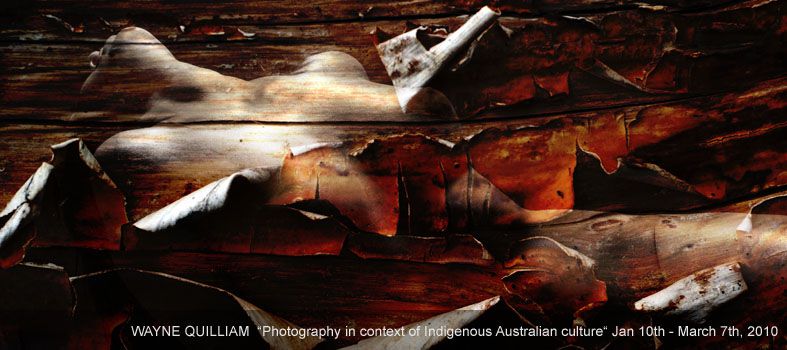WAYNE QUILLIAM
Photography in context of Indigenous Australian culture
January 10th - March 7th, 2010

Wayne Quilliam is considered one of Australia's most prominent Aboriginal photographic artists working on the global stage with more than 130 solo and group exhibitions in Australia, Europe, Asia and the USA. He has been awarded what is considered one of the most prestigious Australian art accolades, the 2009 NAIDOC (National Aboriginal and Islander Day Observance Committee) Artist of the Year. In 2008 he won the Human Rights Award for his work on the Apology with the Koori Mail and was a finalist in the prestigious Walkley Awards for a social documentary on the block in Redfern, Sydney.
Starting from 10th January 2010 the art place berlin in the Park Inn Berlin-Alexanderplatz will present the large-sized photographies of the Lowanna series. The works will be shown in the context of paintings by protagonists of Australia's indigenous art, among others Kudditji Kngwarreye and Jeannie Long Petyarre.
Foreword by H.E. Peter Tesch, Australian Ambassador to Germany:
Wayne Quilliam unquestionably is one of Australia's leading Indigenous artists: in 2009 he received the NAIDOC Artist of the Year award, one of Australia's most prestigious art accolades, while his exhibition Sorry - more than a word in the Australian capital Canberra attracted more than 200.000 visitors. In Europe, Asia, and the U.S., too, he has successfully presented his art.
Making use of a unique metaphorical imagery, Wayne Quilliam skilfully manages to convey the deeply rooted spirituality that pervades Indigenous Australian art and culture. And his documentary work with masterly precision depicts the life - and the living conditions - of Australia's Aboriginal communities.
The images forming part of his impressive Lowanna series in particular also testify to both the quality and the variety of Indigenous Australian art. Indeed, to think of Aboriginal art merely in terms of the justly famous dot paintings and other traditional techniques would be a grave injustice to such outstanding Indigenous Australian artists as author Doris Pilkington, filmmaker Warwick Thornton, or - last but by no means least - Wayne Quilliam.
This exhibition, then, goes beyond showcasing a well-curated collection of photographs and paintings made by Australian artists. It is testimony to the vibrant creativity that has become a hallmark of Australia's Indigenous communities. And, finally, we should not forget that events like this are a valuable contribution to the ever-increasing cultural network between Germany and Australia.

Quilliam's world and iconography is full with strong metaphor exploring spirituality and sublime creation seen from a natural point of view. By manipulating the human form with images from nature he seemingly impregnates his photographs with an essence of life and spirituality.
Traditional Aboriginal stories and tales have influenced the artist's work to become increasingly intense, mysterious, and probing. Quilliam explains, "To interpret my work is akin to demystify the link between myth and reality, I am interested in the process of covering and uncovering the human element of nature; to find depth, meaning and perhaps even a revelation that we are the vision of a 'creator'." "I'm intrigued by the differing perceptions of nudity and the role it plays in modern society" he adds.
Quilliam analyses and deciphers images of the nude female form and of landscapes to engage the viewer. By deconstructing the myth of vulnerability and nudity, Quilliam's opulent abstractions seduces the subconscious to ponder the hidden. The artist covers, hides and camouflages his works to deconstruct, create and recreate a naked reality. Encapsulated by spirituality of nature, the artist deliberately covers and exposes photographs to reveal tensions between the act of representation and reality.
He was born in 1963 in Hobart, Tasmania. In 1979 he left the small island state to join the Navy and explore the world. In 2008 he works and lives in Melbourne when not travelling to some of the most remote locations in Australia and touring the globe with his images. He continues to forge new expressions and dimensions in photographs through his culture and anticipates major growth in contemporary Indigenous art.

